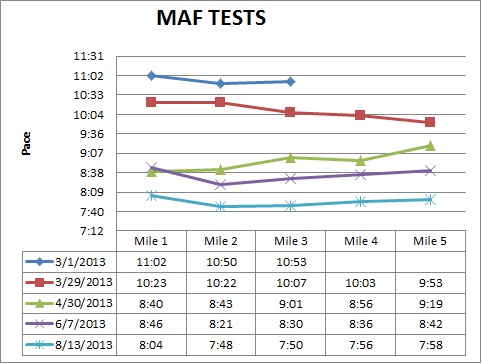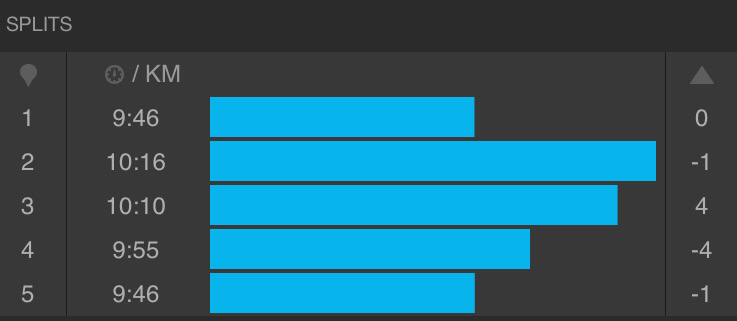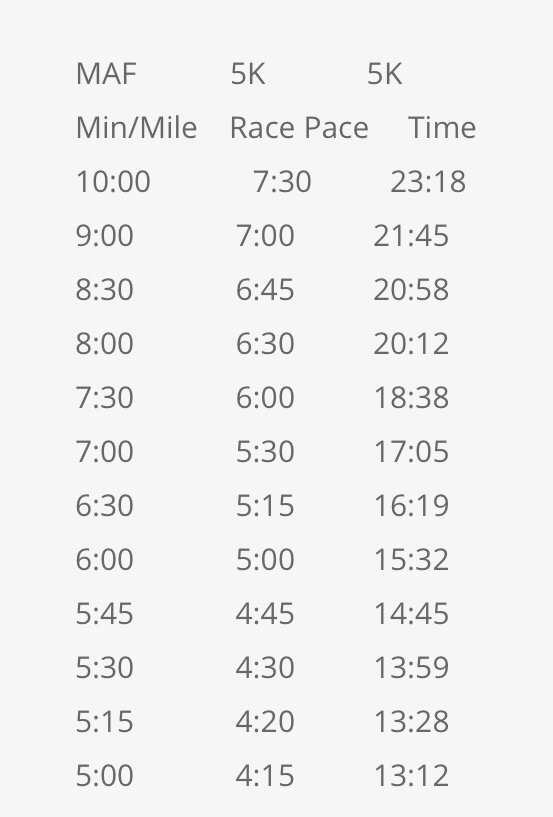Run Slow to Run Faster - The Maffetone Method
It’s not good for the ego to be outrun by a dog walker but that is the short-term risk of adopting The Maffetone Method.
 This weekend I was “running” behind a dog walker for at least 20 minutes, running within yards of him before my heart rate monitor beeped at me and I had to drop to a dawdle. The dog walker edged away until finally, my heart rate edged to the lower end of my training target and I could prepare for the overtake manoeuvre again.
This weekend I was “running” behind a dog walker for at least 20 minutes, running within yards of him before my heart rate monitor beeped at me and I had to drop to a dawdle. The dog walker edged away until finally, my heart rate edged to the lower end of my training target and I could prepare for the overtake manoeuvre again.
This went on for a good 15 attempts before I decided it was probably easier to turn around and head back home.
What is the Maffetone Method
The Maffetone method eschews the no pain no gain ethos, in favour of super low intensity training to optimise aerobic performance.
I came across the Maffetone Method when I was researching different ways to assess and record fitness gains as part of my Achieve the Impossible Challenge and plumped for the MAF Test as an accessible and useful gauge of improving aerobic fitness.
The MAF Test, which stands for Maximum Aerobic Function test, has you run over a set distance between 1-5 miles (in my case 5k) all the time keeping your heart rate within in a set range – the Maffetone Range. The Maffetone Range equates to either heart rate zone 1 or 2 and when you start out it’s really quite difficult to exercise and keep below the maximum allowable rate.
Determining your Maffetone Training Range
Phil Maffetone describes a simple 180 formula to determining your maximum training heart rate.
Step 1) 180 – Age
Step 2) Take this number and adjust by one of the following:
a) Recovering from major illness/surgery then subtract 10
b) Injured, new/returning to training or sickly then subtract 5
c) Consistent trainer (4 days a week for 2 years) then make no change, your max MAF training heart rate is 180 – age
d) Experienced athlete (2+ years) with consistent or improving performance then add 5
As I’m between b) and c) and can’t bear to stick to rules I’ve gone for subtracting 3, so my max training heart rate is 180 – 44 – 3 = 133
To find the range you simply set the lower range at 10 beats per minute lower than your max. So my training range (and MAF test range) is 123 to 133 bpm.
The task then is to conduct a baseline line MAF test and then start Maffetone Training which just means that you have to keep all your training runs, in fact any form of exercise, within the Maffetone Range. You are supposed to avoid all forms of anaerobic exercise until you have reached your aerobic peak which you can identify by a plateauing of your MAF Test performance.
How to do the MAF Test
Pick a course that is convenient and relatively flat, ideally you will want to use the same course for each future test.
You will need to be equipped with a heart rate monitor so you can ensure that you stick to your range. I have set mine to beep every time I fall outside of the range but that’s not necessary, you just need to keep an eye on it. After a while you will get used to how you feel and how your breathing changes when you are in or out of the training range.
You need to do a good warm up before you start the test so that you’ve got your system used to movement but this also needs to be below your maximum training heart rate determined above.
Then you start the run, recording your lap times and finish time.
Having completed the first test you will have an average pace for the entire distance and each individual lap. This is your benchmark from which to compare all future tests.
It is recommended that you repeat the MAF Test every month and as you progress you should note that your average pace decreases even though you are sticking to the same HR range. That means you will run faster and faster for the same aerobic load which has got to be a good thing.
The best example I’ve seen of this is from trifundracing:

The MAF test is remarkably hard. Not in a gruelling way but just because it is too easy. I can’t walk fast enough to stay consistently in my range but neither can I run slow enough. That means I’m trapped in a perpetual run walk cycle and that is challenging when all you really want to do is run.
If you are fitter and lighter than me, you will probably be able to run for the entire duration of the test but it is going to feel painfully slow for you.
So is it worth it?
Only time will tell of course but having spent a bit of time focussing on my heart rate behaviour I am more inclined to give Maffetone Training a good go. The fact that my heart so readily climbs to anaerobic levels under the slightest levels of exertion suggests that I must always be training the anaerobic system. It makes sense to me that I would benefit from a good few months of low level aerobic base training.
In The Big Book of Endurance Training and Racing (*)
Phil Maffetone illustrates his method with case studies and even suggests that some of his athletes eventually struggle to hit their maximum MAF heart rate as they’ve become so aerobically efficient. I find this pretty hard to fathom, from my perspective I barely raise my knee into the running form before my heart rate has jumped by 30 beats. When I actually start running, regardless of pace, my heart rate zone is breached within seconds and I have to drop to a walk. The thought that I might someday be able to sprint at that same heart rate feels a bit mythical. I would settle for being able to jog for an hour at that rate though.
The fact that the MAF test enables me to accurately measure performance improvements is a great bonus and I can’t wait until I manage to run the entire distance, even if it is at a snails pace.
MAF Pace and Race Results
There is apparently a link between the average pace achieved during a MAF Test and your pace at various race distances.
Phil Maffetone includes a table on his site which gives an indicator of how much slower your test pace will be.
It doesn’t cover the slow poke range but to give you an idea of where I am. My MAF Test pace over 5km was 10:00 mins/km while my Bushy parkrun time this week was 41 mins which is a race pace of 08:11 and required an average heart rate of 167 bpm and a max of 185 bpm – definitely not within the Maffetone range.
I’ll be repeating a parkrun monthly to see if I see an improvement after training slow and low.
(*) indicates the use of an affiliate link to amazon



